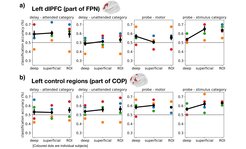Probing the laminar circuitry of the dlPFC during the attentional modulation of working memory
The neural mechanisms of selectively attending to information held in working memory (WM) are not well understood. This high-resolution fMRI study at 7T uses multivariate pattern analysis (MVPA) to investigate the layer-specificity of information processing in the dorsolateral prefrontal cortex (dlPFC) during the attentional modulation of WM. Recent findings about the dissociable functional role of distinct cortical layers led us to hypothesize that attended items can be decoded more strongly than unattended items held in WM in the superficial layers of the dlPFC as these layers have been proposed to act as a WM buffer (Bastos et al., 2018). Contrarily, we hypothesized that subjects’ motor response can be decoded more strongly in deep layers of the dlPFC as those are suggested to be involved in governing action selection/execution (Bolkan et al., 2017; Finn et al., 2019). In a discovery sample we acquired BOLD fMRI data from 4 subjects while they performed a retro-cue working memory paradigm (Fig. 1). The retro-cue working memory paradigm consisted of a slow event-related design with 16 trials per run. For each trial, subjects were presented with two sets of images (consisting of two images from either the house or face category). Subjects were then presented with a retro-cue that indicated whether the first or second set would be relevant for the probe period (i.e., attended category). Following the cued delay period, subjects were presented with an image that was always from the attended image set condition and had to indicate whether this probe was a match using the index or middle fingers of their right hand. In 25% of the trials, subjects were also probed about the unattended image set.

We focused all analyses on the left dlPFC, closely following (Finn et al., 2019) and defined an ROI by selecting regions in dlPFC that are part of the frontoparietal network (FPN; Ji et al., 2019). To assess whether findings are specific to FPN, we selected an anatomically and functionally similar set of control regions belonging to the cingulo-opercular network (COP).
Fig. 2 shows Mean layer-wise decoding accuracy across all parcels of the left dlPFC (part of the FPN) (a) and for comparison, across a control set of frontal parcels (part of the COP) (b). For comparison, we also included mean decoding accuracy across entire parcels (“ROI”, i.e., not layer-wise). Colored dots correspond to the four individual subjects.

We observed better decoding of attended items in both superficial and deep layers of the dlPFC compared to unattended items (Fig. 2a). We did not see any decoding difference between attended and unattended items for the control regions (Fig. 2b). We also observed better decoding for the motor response in the probe period in deep than superficial layers of the dlPFC. While results are in line with our hypotheses on the laminar circuitry of the dlPFC involved in WM, they are not yet conclusive due to the small sample. We used this discovery sample to inform a study pre-registration and acquired data of 25 subjects that we are currently analyzing.













